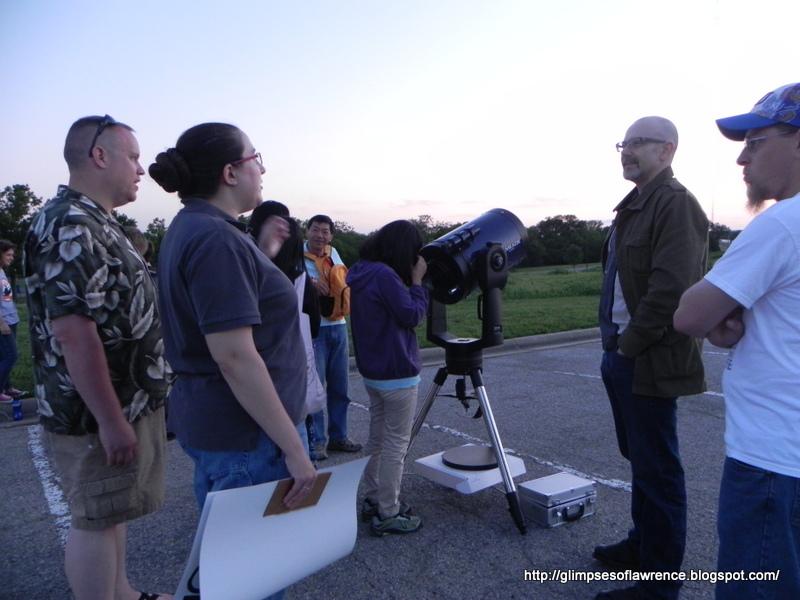(![[personal profile]](https://www.dreamwidth.org/img/silk/identity/user.png) mckitterick Jun. 4th, 2012 01:46 pm)
mckitterick Jun. 4th, 2012 01:46 pm)
Just in case you've been in media blackout for the past week, a heads-up: Tomorrow (in this hemisphere, Wednesday in the East) is your last chance to watch Venus pass across the surface of the Sun for 105 years. So, even granting the Singularity and its attendant eternal-life-for-all, that's a long time. So be sure to catch it if you can.
What you'll need to see it (any of the following will work), in increasing complexity and cost:
Regardless of how you choose to observe, you'll have an infinitely easier time of it than early astronomers did. For example, Captain James Cook's trip to Tahiti in 1769 to observe the Venus transit (in order to measure the size of the Solar System) resulted in the death of 40% of his crew - and that was considered a low death rate! You can make the journey to your local astro-club's viewing party with a MUCH lower death rate - if you promise not to text in your car, and if you wear a helmet while traveling on two wheels.

Click the image to see NASA's story about Cook's mission.
Here's what you'll see:

Click the image to see Sky & Telescope's Viewing Guide to the Transit of Venus.
Here's what Cook saw:

Click the image to see NASA's story about Cook's mission.
Oh, and here's what such a viewing party looks like; this shot was taken by Vijay Vasant Barve during last week's solar-eclipse party in the KU Lied Center's parking lot. That's me with my telescope, wearing a solar filter over the aperture and, I think at that time, also an Oxygen-3 filter. You can't see the other 'scopes behind the folks in the foreground.

Click the image to see more of Vijay's photos from the event.
Get out there and experience astro-history - and relive human history!
Chris
What you'll need to see it (any of the following will work), in increasing complexity and cost:
- Welder's glass or welding helmet. Not magnified, but will allow you to see the black disk that is Venus passing between us and the Sun. It's a true black shadow against a raging inferno of fusion, so it'll be easy to see even at no magnifaction, as opposed to the slightly darker sunspots, which are tough to see without a telescope. The welding helmet is nice because you don't have to hold up the glass for minutes on end.
- A cheap telescope and eyepiece to cast the image of the Sun onto a piece of white paper or cardboard. I say "cheap" because magnifying the light of the Sun makes things toasty, and you might overheat the optics. Insert WARNING here: NEVER EVER NO WAY let that magnified sunshine come near anyone's eyes. Heck, it's nasty on your SKIN, so BE CAREFUL if you go this route. Image is bright white. TIP: Try sketching the image(s) onto the paper, including Venus and any visible sunspots.
- Any telescope or binocular with a solar filter. Be sure the filter (which goes over the light-gathering end of the instrument, not over the eyepiece - that old-school crap only melts) has no holes, tears, etc. This will enable you to see the stuff in the articles and photos you've no doubt been bombarded with. Image is orange.
- If you combine the full-aperture filter on your telescope with an enhancing solar filter for your eyepiece, you can see even more detail. I have an Oxygen-3 "solar continuum" filter that enhances solar-surface activity, and a Hydrogen-alpha filter better for solar-limb activity, but you can try other colored filters to draw out different details.
- A true solar telescope that uses Hydrogen-alpha coatings and special lenses and eyepieces. Heck, if you have one of those, you don't need to read this. They're fantastic, because H-a filters enable the observer to witness solar flares, prominences, and so forth. Image is red.
- Or, y'know, just watch it live online, at websites like these. These will probably provide the best images, but you'll miss the social aspects, and there's something ephemerally satisfying about doing astronomy yourself, those faraway photons bouncing around inside your own optics, hitting your own retina, instead of being manufactured by a computer screen. It's real, even if less convenient. This is why I own two telescopes and still feel such great joy whenever I point one at something like the Moon, even though I've viewed it thousands of times over the years.
Regardless of how you choose to observe, you'll have an infinitely easier time of it than early astronomers did. For example, Captain James Cook's trip to Tahiti in 1769 to observe the Venus transit (in order to measure the size of the Solar System) resulted in the death of 40% of his crew - and that was considered a low death rate! You can make the journey to your local astro-club's viewing party with a MUCH lower death rate - if you promise not to text in your car, and if you wear a helmet while traveling on two wheels.

Click the image to see NASA's story about Cook's mission.
Here's what you'll see:

Click the image to see Sky & Telescope's Viewing Guide to the Transit of Venus.
Here's what Cook saw:

Click the image to see NASA's story about Cook's mission.
Oh, and here's what such a viewing party looks like; this shot was taken by Vijay Vasant Barve during last week's solar-eclipse party in the KU Lied Center's parking lot. That's me with my telescope, wearing a solar filter over the aperture and, I think at that time, also an Oxygen-3 filter. You can't see the other 'scopes behind the folks in the foreground.
Click the image to see more of Vijay's photos from the event.
Get out there and experience astro-history - and relive human history!
Chris
Tags:
From:
no subject
From:
no subject